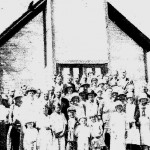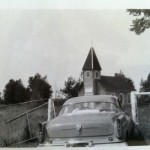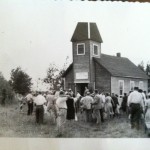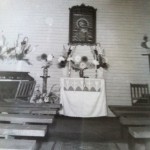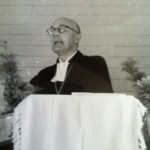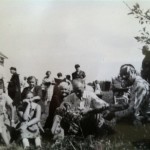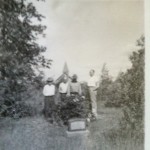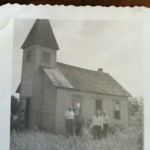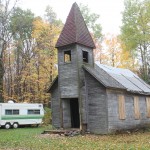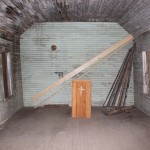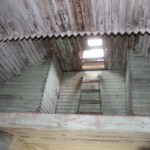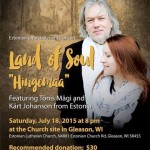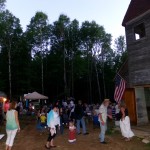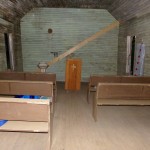Jeremy Ratliff
Reporter
Nearly 150 visitors including Estonian-Americans from around the U.S and Canada, converged on the Gleason area on Saturday evening, for the much anticipated “Hingemaa” or “Land of Soul” concert by Estonian rock legend Tònis Mägi,and his wife, singer/acrtess Kärt Johanson. The concert was a fund raising effort to restore a once abandoned 108-year-old Estonian church, one of the only remaining churches of its kind in the U.S.
According to event organizer and guest speaker Bill Rebane of Saxon, WI, the event soared above and beyond expectations.
“Myself and many of the volunteers and organizers arrived early last week to begin setting up and so forth,” Rebane explained. “We made bets for fun, on how many would actually show up for the concert. Most guessed 50 to maybe 75 or so at the very most. Then as early as Wednesday, cars and vans started coming down the road. They continued to pour in as late as 8:15 Saturday night!” he added. “We were so wonderfully surprised!”
The concert began at 8 p.m. and lasted until 9:30. Along with the appearance of Mägi and Johanson, was special guest Rupert Encinas, Baag-Da (Flying Eagle), spiritual leader of the Tohono O’odham, a Native American tribe located in Arizona.
Desserts and treats were served for a nominal fee as well as a “Borscht” dinner.
According to Rebane, Borscht is a traditional vegetable soup first created in Russia, but Estonians as well as other nations in the area have since adapted their own recipes.
Mägi and Johanson flew in to Chicago from Estonia on Thursday evening, and accompanied a television crew from Estonia on the drive to the church.
“We were very lucky to have Mr. Mägi perform for us!” Rebane explained. “He is legendary and receives requests year around from all over the world to come and play, for a pretty hefty price usually. He was unsure at first, but when we explained the cause and our plight to preserve our history there, he was more than happy to come. He loved it down there! All the visitors loved it!” Rebane added.
“Tönis and his wife told me when they arrived on Saturday, how much that area reminds them of home. In fact, that is why so many Estonians and other immigrants from the Baltic nations chose the Gleason area when they were fleeing from communist oppression. That area and landscape are so very similar to our homeland,” he said.
The event raised approximately $4,000, although a final dollar amount has yet to be announced. Rebane says every dollar will go into restoring the church.
“Our big project now is replacing the roof and windows,” he said. “We would like to try and get that done before winter comes.”
Bill Rebane as well as the many Estonian-American volunteers and visitors this weekend would like to express their sincere appreciation and gratitude to Wisconsin Public Service Corporation for their assistance in providing electrical service for the event as well as the Town of Schley Board for all of their assistance and generosity in planning and preparing the event.
The Rise, Fall and Resurrection of the Estonian Evangelical Church of Martin Luther
The Estonian Evangelical Lutheran Church (EELC) was the first Estonian church built in North America and was first established in 1907, near what is now County Roads X and J near Gleason. According to historical records, the church was dedicated in 1914 by founding fathers: Johan Wiltein, George Tutt and Albert Sommi.
Hans Rebane, a member of the Missouri Synod, came from Boston in 1908 to become the church’s first pastor.
According to Bill Rebane, Hans’ grand-nephew, the church was attended regularly for worship services by local Estonian immigrants.
“Estonian and Latvian immigrants came to this specific area in late 1800s,” Rebane explained. “They came to the United States, hoping to escape religious oppression in the Baltic republics. More specifically, the reason for the church’s re-dedication in 1996 was to honor all those who have fallen under the oppression of communism.
“The local immigrant population came to this area from New York, Chicago and some even directly from Estonia, due to the area landscape being so similar to their homeland,” he added. “It was sort of a home away from home for them. Both the Estonians and the Latvians were a very hard working community. Most of them took advantage of the land for farming, while others got into logging.”
The church would see several pastors come and go through the 1930s. As time passed, some of the immigrants sold their farms and moved on to more populated areas. The prominent Pay brothers however chose to stay in the area, but shifted their support to St. Paul Lutheran Church in Irma. Eventually, events at the church ceased to exist, except for occasional picnics and gatherings by Estonians who took pride in this historic landmark. The lack of attention and use left the sacred structure open to vandals and in 1961, the church found itself completely abandoned.
It would remain that way for another 31 years.
In 1992, Bill Rebane and family stepped forward, retaining legal counsel and filed reorganization documents with the county, reinstating the church as the “Estonian Evangelical Martin Luther Church.”
“That is what the church is known as today and that is how it will remain,” Rebane said.
After reinstating the church, Rebane attempted to ignite a restoration campaign, but lack of interest and communication soon bogged down his efforts. This past summer though, that all changed.
“The internet made it easier to find opportunities for funding and communication,” he said. “Before, I had to rely on word of mouth and handwritten letters to spread the word to the Estonian communities around the country. We had no money to do anything to save the church and it was a real uphill battle for us. But back then. I couldn’t get anyone to listen or respond. Nobody had any interest, including Estonians in the Merrill area.
“However, now with our ‘gofundme’ page and other information we have put out there, people are responding.”
Beginning last summer, a group of approximately 20 Estonian volunteers from the Chicago area have made intermittent visits to the church and began restoration efforts on the worn structure. Since then, important milestones to preserve the building have been made, including: securing of foundation footing, squaring up of the main structure and temporary doors.
Thanks to the generosity of the Kleinschmidt family of Merrill, benches in near new condition and a new baptismal have also been placed in the church.

